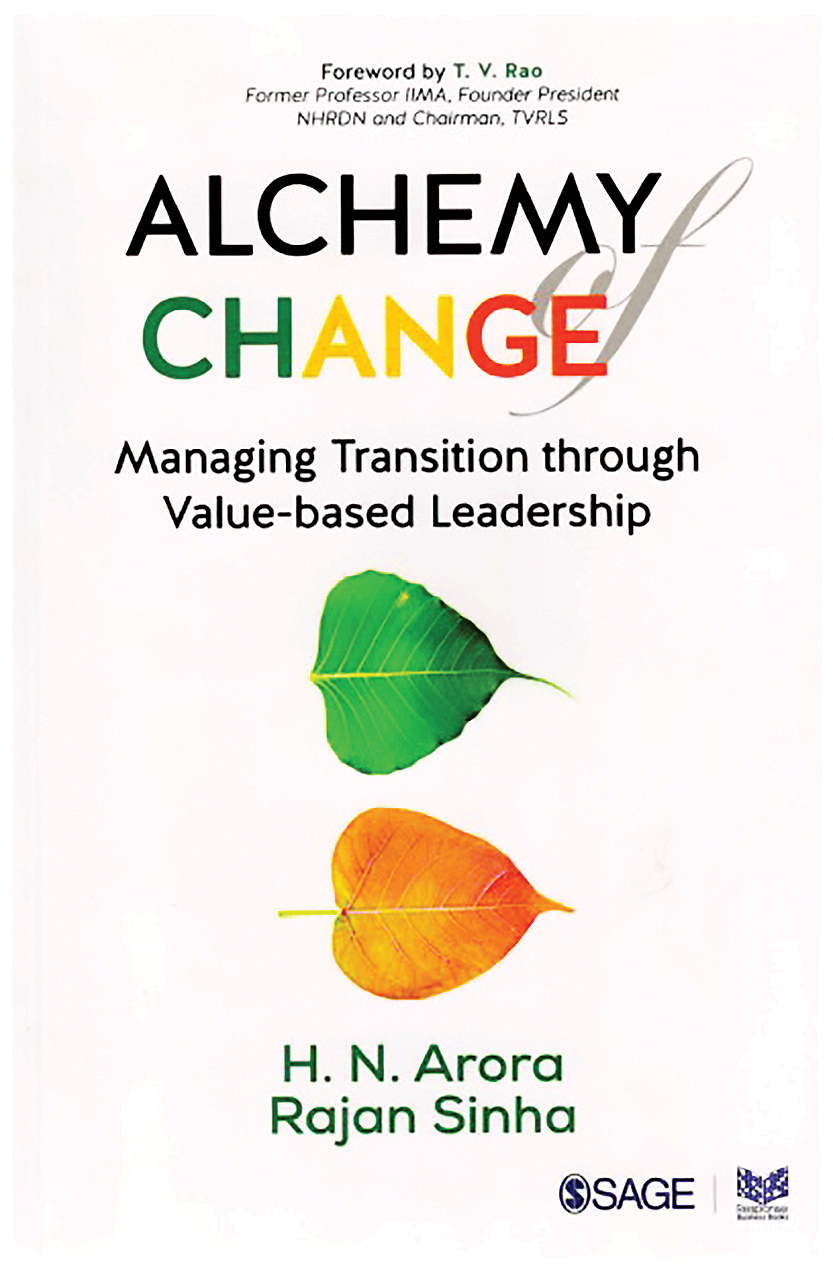This book is a valuable addition to the literature on change management, essential for the corporate sector if it is to stay in step with fast-changing ground realities
Indian society has a consensus that once a youngster in his twenties finishes his studies and gets a job, he is ‘settled’. However, the authors HN Arora and Rajan Sinha warn, “The status of work has changed. The old skill sets are getting outdated at an ever-increasing pace and so is the concept of job security.” The job that exists now may disappear completely in another 10 years.
The world is changing so fast, thanks to technological advancement, that one has to keep pace with change or lose one’s place in the workforce. The blurb of Alchemy of Change says that this book ‘is a must-read for business leaders, human resource professionals and scholars with interest in change management’. But for the general reader, too, there is much to amuse, for it tells them how bosses are supposed to behave. Very few CEOs and supervisors in the so-called ‘organised sector’ handle their staff in the manner laid out by management theory.

Therein lies an irony. If the idealistic view is that human resources are the most valuable in an enterprise, the reality on the ground is that ‘staff’ is seen by bosses as eminently replaceable, best kept at a distance and never made privy to changes being planned at the top. It bears repeating, however many management books might have driven home the point, that emotional involvement of an employee comes only from a sense of ownership. “We are dealing with emotions of people while trying to change their mental models and mindsets, and this has to be done with a lot of persistence, tact and sensitivity.”
The authors are consultants: HN Arora is an HR consultant and change facilitator while Rajan Sinha is CEO of Mantrana Consulting. In a way, they are outsiders who enter an organisation to make a time-bound intervention. It is easier said than done when they say, “The success of teamwork depends largely on the capacity of individuals to look beyond their narrow horizons of esteem, preferences and gain, by following the path of self-restraint, self-control and renunciation. If a team is to reach its potential, each team member must be willing to subjugate his personal goals for this higher purpose.” The financial rewards every employee expects may not come even after such self-abnegation.
In another context and on a later page they write, “People emulate and draw inspiration from the conduct of their superiors. We cannot hope to create an atmosphere for change when the top team is perceived to be a non-cohesive group of individuals pursuing individual goals at the cost of organisational goals.” The cynicism that pervades a lot of enterprises actually trickles down from the top, and is not generated in the trenches.
The best part of the book are three case studies of companies which are not named, but called Mega Corporation, AB Corporation and Akash Industries. The description of a bad company culture would be cathartic for readers, unless they have actually worked for one of the companies judged among the best to work for. Trade unions are of course frowned upon by the corporate sector, and are blamed for many of the ills of a company, especially managers feeling helpless because the unions are so powerful.
An interesting – and instructive – suggestion is that small victories should be part of the change process, not just meeting the big goal set out. “Even in our personal lives, we need small wins to maintain emotional well-being…Similarly, these wins are critical in the change process as they provide credibility, promote faith in the change effort, emotionally reward the hard work, keep the critics at bay, and provide impetus to the overall effort.” They also motivate sceptics and fence-sitters to join the effort, as the gains become visible.
The narrative is low on anecdotage, especially Indian ones, which would have been a welcome break from generalisations. One story that is told about Madan Mohan Malviya waiting in the anteroom to meet industrialist GD Birla for a donation to his dream project, the Banaras Hindu University. He heard Birla shouting at his son for wasting many matchsticks before lighting a candle. He thought there was no point in asking such a stingy person to donate a big sum. But Birla generously gave him a big cheque. When Malviya asked for an explanation about the scolding he had given his son, Birla laughed and said that just because he has a lot of money, he cannot allow waste as this creates trust.
A person of character, say the authors, displays “a pattern of behaviour, thoughts and feelings based on universal principles of moral strength and integrity – plus the courage to live by these principles each day. This high character is what makes people believe in you and look up to you as a leader.” Obviously, Vijay Mallya and Nirav Modi do not fall in this category. Mallya’s licentious behaviour while in India should have been adequate warning of what was to come.
The book is peppered with quotes from Western management gurus. However, at the end, the authors admit that Western theories and cultural constructs “may not be consonant with Indian mental models.” One of these constructs is ambivalence. Empl-oyers do not directly tell off wrongdoers. Another is the tendency not to admire those who are rich. Instead, there is admiration for those who sacrifice, who renounce, who give up material wealth – like the Buddha did, or Swami Vivekananda, or indeed Narayana Murthy when he gave up his CEO title for Chief Mentor in 2002. Indians also lack a competitive spirit or what is called the killer instinct. n





